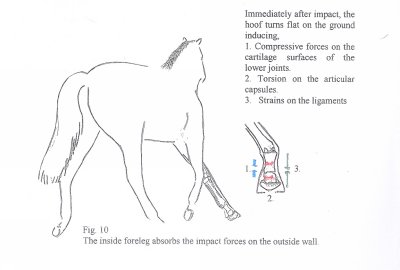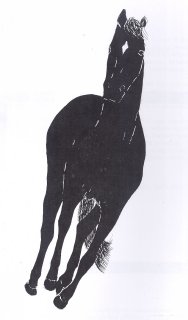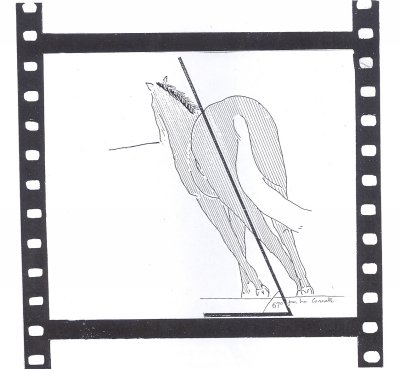Mechano-responsiveness PT 3
Mechanoresponsiveness
Part 3
Jean Luc Cornille
Injecting the horse’s hocks or stifles with hyaluronic acid or other drugs, might provide transient relief at one scale but the root cause of the problem resides at another scale. “The long-standing inability to effectively alter the structural damages in knee osteoarthritis with the current therapeutic paradigm is the result of a persistent overemphasis on articular cartilage as the primary outcome of joint failure. This myopia has been misdirected and fails to address the root cause of the disease. Although its etiology is likely multifactorial, it is now generally accepted that osteoarthritis onset and propagation are mediated largely through biomechanical forces acting across the joint and the failed repair of damage caused by excessive mechanical stresses and loading on joint tissues.” (Craig Waller, David Hayes, Jon E. Block, Nicholas J. London Unload it: the key to the treatment of knee osteoarthritis. 2011)
Pharmaceutic companies have spent millions of dollars trying to find the drug curing arthritis. The problem is that while many studies have focused on the cartilage, a new generation of researches has demonstrated that the problem started in the subchondral bone. Instead of focusing on the cartilage, the real cure is focusing on the stresses loading the subchondral bones. The dogma of new therapies is, “Unload it”.

The load altering the joints might relate to absolute weight, but also, direction, frequency and intensity of the forces acting on the joint. At the lunge for instance, a horse leans toward the inside of the circle. Whatever the system and lunging technique applied, the horse might bend the neck but does not bend the thoracic vertebrae. As a result, the horse’s body leans toward the inside of the circle. The study, based on video recordings, was effectuated on 76 horses lunged by their respective trainers using different systems and lunging techniques. The average body angle was 67°

Due to the angle of the horse body, the hoof of the outside front limb as well as the outside hind limb impacts on the inside wall. In 1986, Jean Marie Denoix correlated the torque induced on the third metatarsal bone with the development of osteoarthritis in the hock joint. “Preferential support of the hoof on the inside wall during ground contact and push-off concentrates compressive forces on the internal face of the hock joint, where the articulation is particularly prone to degenerative phenomena (arthritis) leading to spavin.” (Jean Marie Denoix, Biomechanique et travail physique du cheval de sport. 1986) Arthritis in such case does not result from absolute weight since balance is not achieved increasing the weight on the hind legs. The culprit is the direction of the forces acting on the internal face of the hock joint.
The phenomenon that Graig Wakter describes as a persistent overemphasis on articular cartilage as the primary outcome of joint failure, applies to all equine injuries. There is a persistent overemphasis on the symptoms but constant failure to address the root cause. This applies to training techniques as well. Ignorance claims that a horse can learn straightness between a bamboo pole and the wall. The myopia completely ignores the layers of muscular coordination that the horse’s brain has to orchestrates in order to achieve straightness.“The existence of discrete network within discrete networks in bones, cartilages, tendons and ligaments optimizes their structural efficiency as well as energy absorption.” (Christopher S. Chen and Donald E. Ingber. Tensegrity and mechanoregulation: from skeleton to cytoskeleton, 1999)
Efficiency and therefore ease and therefore class and therefore soundness, demands a horse’s physique precisely coordinated for the effort. When peoples don’t know, they judge and this is what riders and trainers do when they don’t understand the underlying biomechanics factors. They judge the horse in respect of his obedience to the rider’s aids instead of analyzing the horse’s difficulties and identifying the root cause.
The horse’s errors are the most accurate information that the rider can ever have. The horse errors are the most accurate descriptions that the horse can provides to the rider about its actual muscle imbalance or other coordination issue. The task of the rider as well as the trainer, is not judging the horse. The rider’s responsibility is analyzing the horse’s difficulties and providing insights leading the horse’s brain toward a more efficient coordination.
Systems within systems, networks within networks expose the fact that we can eventually stimulate through our physique the most superficial systems but this form of equitation, “obedience to the rider’s aids”, does not allows subtle orchestration of the horse’s physique. When straightness is asked between a whip and the kickboard, only a gross imitation of straightness can be achieved. In spite of elementary training techniques and out of his talent a horse executes dressage or jumping performances but his dysfunction causes the lesions.
At a deeper scale, contractile microfilaments and microtubulures respond to stress independently of the horse’s brain, but many layers of any equine athletic performances are out of reach of rider stimulus and fully controlled by the horse’s brain. The horse brain is interested in ease and physical comfort and process toward muscular coordination far more sophisticated than natural reflexes if the dialogue with the rider is about preparing the horse’s physique for the athletic demand of the performance. If allowed, and even encouraged, the horse’s brain will explore subtlety of the horse physique that obedience to the rider’s aids never even approach.
Class, which is, or more exactly should be, the aim of classical equitation, is the touch that the horse’s intelligence and spirit add to the performance when the development of the horse’s intelligence and the respect of the horse’s spirit have leaded to an athletic development and a coordination of the horse’s physique precisely adapted to the physical demand of the performance.
Jean Luc Cornille 2015



 twitter
twitter facebook
facebook google
google stumbleupon
stumbleupon tumblr
tumblr pinterest
pinterest yahoo
yahoo linkedin
linkedin
